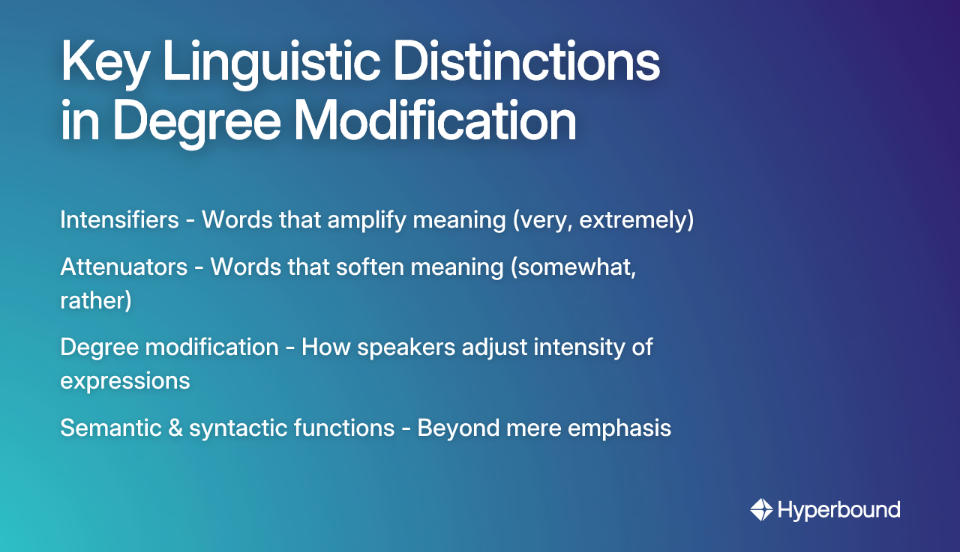
You read a writing guide that advises "eliminate qualifiers for stronger prose," but when you try to look up what exactly counts as a "qualifier," you find only simplistic writing advice rather than solid linguistic information. The term seems to lump together words like "very," "somewhat," "rather," and "quite" without any clear distinction, leaving you frustrated and confused about which words to use and when.
The truth is that prescriptive grammar's vague umbrella term "qualifier" obscures important linguistic distinctions that are crucial for precise communication. To truly understand how we modify meaning, we need to explore the more precise linguistic categories of intensifiers and attenuators – two distinct types of degree modification with different semantic properties and communicative purposes.
Moving Beyond "Qualifiers": Understanding Degree Modification

In descriptive linguistics, we rarely use the term "qualifier" because it lacks precision. Instead, linguists study degree modification – how speakers adjust the intensity of qualities, actions, or states. This approach gives us a much richer understanding than simply labeling certain words as "weak" or telling writers to avoid them.
Intensifiers: Amplifying Meaning
Intensifiers are words that increase or amplify the strength of the expression they modify. They heighten the degree of a quality or action:
- very (tall)
- really (interesting)
- extremely (difficult)
- incredibly (fast)
- absolutely (perfect)
When you say someone is "very tall," you're indicating a significant, noteworthy height that exceeds the typical range. The intensifier "very" strengthens the basic meaning of "tall."
Attenuators: Softening Meaning
Attenuators, by contrast, decrease or lessen the strength of the expression they modify. They reduce intensity:
- somewhat (disappointed)
- rather (unusual)
- quite (good)
- slightly (uncomfortable)
- fairly (reasonable)
Saying someone is "somewhat tall" suggests a more moderate height – still above average, but not remarkably so. The attenuator "somewhat" softens the judgment.
This distinction already reveals why advice to "eliminate qualifiers" is problematic – intensifiers and attenuators serve fundamentally different semantic functions and cannot be treated as a single grammatical category to avoid. As linguistic research has shown, they operate differently within the semantic structure of sentences and fulfill distinct communicative needs.
Semantic and Syntactic Differences
The distinction between intensifiers and attenuators goes beyond simply making something "more" or "less." These degree modifiers have complex semantic and syntactic properties that reveal their distinct linguistic functions.
Semantic Function: More Than Just Emphasis
Intensifiers don't just emphasize; they can convey stronger emotions, certainty, or urgency in communication:
- "I'm really concerned about this issue" expresses deeper worry than the unmodified statement.
- "She's extremely talented" indicates exceptional ability, not just talent.
These expressions add a layer of emotional force that isn't present in the unmodified versions, helping speakers communicate not just information but also their attitude toward that information.
Attenuators, meanwhile, imply moderation and can serve strategic communicative purposes:
- "The presentation was somewhat disappointing" softens criticism, making it more diplomatic.
- "I'm rather interested in your proposal" expresses cautious or qualified interest.
In studies of pragmatics, attenuators are recognized as important tools for politeness, hedging, and expressing uncertainty – all crucial aspects of social communication that go beyond mere description.
Syntactic Position and Collocation
These words don't just appear anywhere in a sentence. Their usage follows specific syntactic patterns:
- Intensifiers typically modify positive (base) forms of adjectives: "very happy," "extremely hot"
- Some attenuators can link with comparative forms: "rather better," "somewhat taller"
- Certain intensifiers and attenuators collocate with specific words based on established patterns in the language
These collocation patterns aren't random. For example, we say "deeply concerned" but rarely "deeply happy." We might say "extremely important" but not typically "extremely big." According to research on collocation patterns, these syntactic restrictions reflect deep semantic relationships between modifiers and the words they modify.
Evolving Intensifiers and Semantic Bleaching
Some words evolve from having concrete semantic content to functioning purely as intensifiers – a process linguists call semantic bleaching. The word "literally" provides a fascinating example:
- Original meaning: "in a literal sense, not figuratively"
- Evolved usage: as an intensifier meaning "very" or adding strong emphasis
This evolution has caused considerable debate in pop-grammar circles, with prescriptivists claiming the word is being "misused." However, from a descriptive linguistics perspective, this is simply a natural semantic change that has occurred in many intensifiers throughout history. Words like "very" (from Latin "verus" meaning "true"), "really," and "actually" have all undergone similar transformations.
Cross-Linguistic View: What 'Degreeless' Languages Reveal
Not all languages express degree modification the same way English does. Some languages, termed "degreeless," lack dedicated words like "very" or "somewhat" to express gradation. Examples include certain tribal languages in the Pacific Islands, such as Samoan and some Australian Aboriginal languages.
In these languages, speakers use alternative strategies to convey intensity or attenuation:
- Context: The meaning is heavily dependent on the situation and shared understanding between speakers
- Descriptive Phrases: Instead of "very big," a speaker might use a more descriptive expression or a different lexical item that implies size
- Repetition: Some languages use repetition (e.g., "big-big") to indicate higher degree
- Prosodic Features: Changes in tone, pitch, or stress can indicate intensity
This cross-linguistic evidence demonstrates something profound: while degree as a conceptual category appears to be universal, its linguistic expression varies dramatically. This undermines the prescriptive notion that there's a "correct" way to express degree, suggesting instead that these are flexible tools that languages develop to meet communicative needs.

The Communicative Purpose: Why We Need These Words
The minimalistic style advocated by many writing guides often discourages the use of degree modifiers, suggesting that florid vocabulary and precise adjectives should replace words like "very" or "somewhat." This advice stems from linguistic prescriptivism rather than an understanding of how language actually functions.
The Function of Intensifiers

Intensifiers serve critical communicative purposes:
- Conveying Emotion: "This is really amazing!" expresses enthusiasm in a way that "This is amazing" alone might not.
- Signaling Urgency: "It's extremely important that you listen" communicates a higher level of priority.
- Building Social Connection: Using intensifiers can signal engagement and shared excitement, helping to establish rapport between speakers.
Research in mediated communication suggests that these emphasis markers are crucial for maintaining connection when other cues (like facial expressions) are absent.
The Function of Attenuators
Attenuators are equally important for sophisticated communication:
- Politeness and Hedging: "I'm somewhat concerned about this proposal" softens criticism, showing respect for the recipient.
- Expressing Nuance and Uncertainty: "The results are rather promising, but we need more data" acknowledges limitations in our knowledge.
- Cultural Context: In many cultures, direct statements without appropriate attenuation can be perceived as rude or aggressive.
These functions vary significantly across cultures, making attenuators a key part of pragmatic competence in cross-cultural communication.
Common Pitfalls in Degree Modification
Understanding the distinct categories helps avoid common errors:
- Improper mixing like "very somewhat" violates semantic constraints because intensifiers and attenuators operate at cross purposes.
- Some words, like "quite," can function as either intensifiers or attenuators depending on context and regional usage, creating potential ambiguity.
- Overreliance on certain intensifiers (like "very") may indeed weaken writing, but the solution isn't to eliminate all degree modification – it's to use it purposefully. For sales teams, mastering this nuance is critical for building rapport and closing deals. AI coaching platforms like Hyperbound can analyze sales calls and provide reps with targeted feedback on their use of language, helping them practice and refine their communication skills in realistic scenarios.
Conclusion: Embracing Linguistic Nuance
Intensifiers (like "very") and attenuators (like "somewhat") are precise linguistic tools for degree modification that serve distinct communicative functions. They are not interchangeable parts of a vague category called "qualifiers" but represent different semantic operations with different effects on meaning.
While some degreeless languages express similar concepts through other means, the prevalence of degree modification across languages suggests its fundamental importance to human communication. Cross-linguistic evidence reinforces that while the form may change, the need to express degrees of qualities is universal.
Rather than following rigid rules that ban certain words, a skilled communicator understands the full toolkit of degree modification and uses intensifiers and attenuators deliberately to convey precise meaning, emotion, and social nuance. The goal isn't to eliminate these words from our vocabulary, but to employ them thoughtfully and effectively.
By moving beyond prescriptive grammar's simplistic treatment of these words as "qualifiers" to avoid, we can appreciate the rich semantic and pragmatic roles that intensifiers and attenuators play in creating meaningful, nuanced communication across contexts and cultures.

Frequently Asked Questions
What is the main difference between intensifiers and attenuators?
The main difference is their effect on the words they modify: intensifiers amplify or strengthen meaning, while attenuators soften or lessen it. For example, "very hot" uses an intensifier to indicate a high degree of heat, whereas "somewhat hot" uses an attenuator to suggest a more moderate level. They serve opposite semantic functions.
Why do many writing guides advise against using "qualifiers" like "very"?
Many writing guides advise against "qualifiers" because they can sometimes be a sign of lazy or imprecise writing. The argument is that instead of saying "very big," a stronger choice would be a more descriptive adjective like "enormous" or "massive." However, this advice oversimplifies the issue by grouping all degree modifiers together and ignoring their specific, often necessary, communicative roles.
Should I completely eliminate intensifiers and attenuators from my writing?
No, you should not completely eliminate them. While overusing words like "very" can weaken prose, intensifiers and attenuators are crucial linguistic tools for expressing nuance, emotion, and politeness. The goal is not elimination but purposeful use. A skilled communicator uses these words deliberately to achieve a specific effect, whether it's conveying urgency with an intensifier or softening a critique with an attenuator.
How do intensifiers and attenuators improve communication?
Intensifiers and attenuators add critical layers of meaning and social nuance. Intensifiers can convey strong emotions ("I'm really excited"), signal urgency ("This is extremely important"), and build rapport. Attenuators are essential for politeness ("That's somewhat incorrect"), expressing uncertainty ("The results are rather promising"), and hedging claims, which are all vital aspects of sophisticated, socially-aware communication.
What is an example of semantic bleaching?
A prime example of semantic bleaching is the word "literally." Originally meaning "in a literal, non-figurative sense," it has evolved to also function as a general intensifier for adding strong emphasis, similar to "really" or "very" (e.g., "I was literally so tired"). This process, where a word loses its original semantic content to serve a grammatical function, has also happened to words like "very" (from Latin for "true") and "awfully" (from "full of awe").
How can I use degree modifiers effectively?
To use degree modifiers effectively, focus on precision and purpose. Instead of relying on the same few words like "very," expand your vocabulary to include a range of intensifiers ("extremely," "incredibly," "deeply") and attenuators ("somewhat," "rather," "fairly"). Use them intentionally to control the tone and meaning of your message. For instance, use an intensifier to add genuine emotional weight and an attenuator to be diplomatic or express cautious optimism.
Book a demo with Hyperbound
.png)













